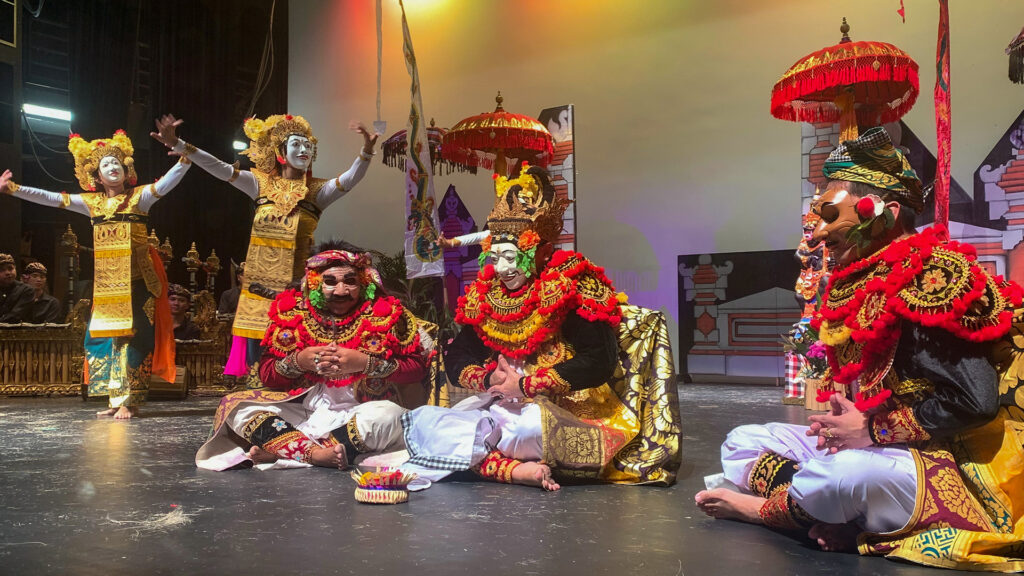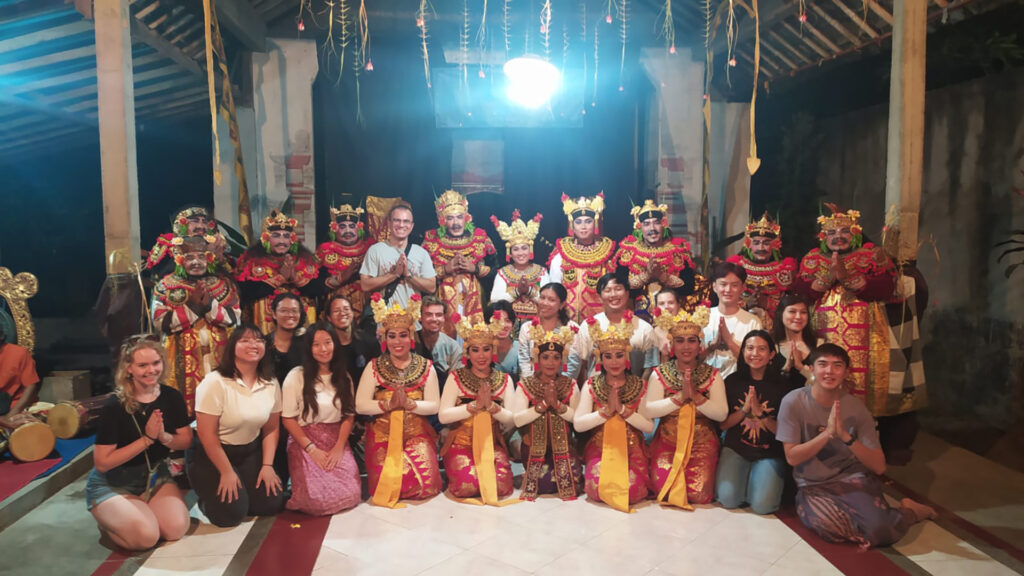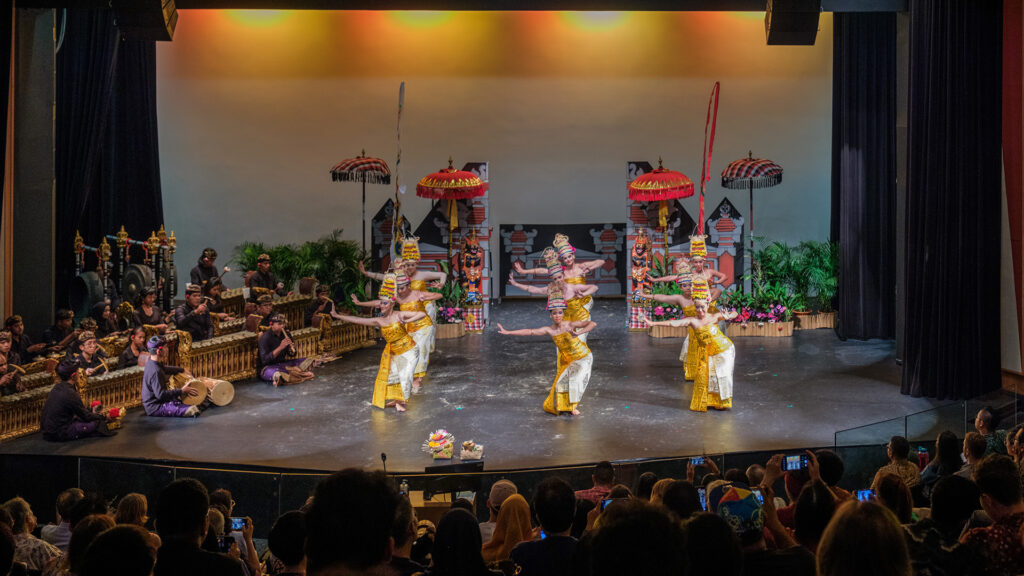Learning about Southeast Asian History and Culture through Balinese Dance
November 23, 2023
IN BRIEF | 5 min read
- Students from SE2224: Unmasked: An Introduction to Traditional Dance in Southeast Asia performed “Sutasoma: The Journey”, a mesmerising rendition of the Balinese literary classic. This marks a pioneering showcase of the tale in the Topeng Prembon genre.

It was a feast for the senses from the moment the performance began. Buoyed by the melodious, almost hypnotic, Balinese gamelan music, actors – some wearing beautifully carved masks – moved and sang in a wonderful blend of Old Javanese, Balinese, Bahasa Indonesia and English as they took centrestage to perform “Sutasoma: The Journey” – a 14th-century Javanese poem depicting Buddhist prince Sutasoma’s journey towards enlightenment and the obstacles he encounters along the way with his eclectic group of friends: a tiger, a dragon and a flesh-eating elephant-headed demon.Directed and produced by NUS Southeast Asian Studies' Associate Professor Irving Johnson, this Balinese dance drama showcases a timeless story woven around the theme of kindness and compassion for all living things. The performance is the fruitful cap to the SE2224 course he teaches at the Department of Southeast Asian Studies. The show was notably the first time that the story of Sutasoma was performed as Topeng Prembon – a Balinese dramatic dance presentation that involves masked and unmasked actors.
Titled “SE2224: Unmasked! An Introduction to Traditional Dance in Southeast Asia”, the non-examinable course introduces students to classical Southeast Asian dance with a particular emphasis on masked dance traditions. Through the analysis of scholarly texts, videos and hands-on sessions, students are taught how to appreciate classical dance traditions in the region from a variety of angles, such as dramaturgical principles, music, aesthetics, ritual significance and change. Students will also have to participate in an organised field trip and perform in a staged performance at the end of the course. Open to all NUS students, the course is available in the first semester of each academic year.

“In SE2224, we dissect the meaning of ‘tradition’ and study dance in Thailand, Malaysia, Indonesia and Singapore. Take Singapore for example. We discuss how occasions like Chingay, the People’s Association and the National Arts Council are instrumental in constructing new ‘traditions’. We also examine how the Association of Southeast Asian Nations as a bloc impacts dance traditions in the region,” said Assoc Prof Johnson, who is himself a Balinese dancer and Thai mural painter.
He added, “This year, Bali was the case study for learning about dance in Southeast Asia. Topeng Prembon was the genre of Balinese dance we chose for Sutasoma.”
A Field Trip to Better Appreciate Balinese Culture, History and Dance Traditions
For a full immersion into Balinese dance traditions, Assoc Prof Johnson brought all 14 SE2224 students for an experiential seven-day field trip to Bali. They took dance lessons every morning from local teachers, visited religious, cultural and historical sites such as the 1,000-year-old temple in the village of Batuan, and the old palace at Klungkung where they saw first-hand the paintings of the story of Sutasoma to better appreciate Balinese dance and the drama they were performing.



Chai Jia Xin, a third-year NUS Nursing student observed, “After watching several Balinese performances during the trip, I discovered that their style of art feels more intimate. Unlike seats in a theatre, the audience is seated on the ground with nothing physically separating the performers and the audience. The gamelan musicians also laughed at jokes or spoke to each other while the show was ongoing. It was an eye-opening and wonderful experience.”
Offering another perspective, FASS fourth-year student Timothy Timuari shared, “Almost all of us have no experience in traditional dance. I chose to take SE2224 because it exposed me to ethnography. By fully immersing myself in a Balinese village with the folks there, I experienced so much about Balinese culture and learnt quite a bit about life. This is not something that readings can teach.”
A Unique Course that Offers Important Lessons

The sound of appreciative applause from a 280-strong audience rang loud and clear as Sutasoma came to a moving close. From the stands, it was apparent that the student performers as well as the rest of the cast enjoyed themselves throughout the three-hour spectacle. Indeed, the production was a truly collaborative one as it not only involved alumni from the Department of Southeast Asian Studies but also professional dancers and musicians from the Balinese dance and music community in Singapore and Bali.
This cross-cultural experience was not lost on anthropology exchange student Pablo López Basurco who played the role of the elephant-headed demon or Gajah Waktra. “If you’d asked me in August, I would never have thought I would travel to Bali to learn how to dance and perform in Singapore. I study in the Netherlands and I could never imagine a project like this taking place there. This is truly a unique experience.”
Assoc Prof Johnson shared, “With this class, I wanted to show students that dance is just as relevant a subject as any of the other disciplines. To dance is to be human and the SE2224 course not only teaches us important things about our bodies, our mind and our community. It also teaches us about happiness, respect and patience. These are precious lessons that my students will carry with them long after their university days.”

This story first appeared in NUSNews on 23 November 2023.

